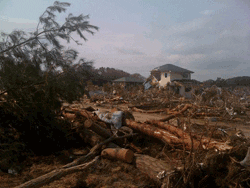In the aftermath of the massive earthquake off the coast of Japan, international aid agency Oxfam continues to closely monitor the situation and is beginning to respond where appropriate. Initial reports from several Pacific countries suggest tsunami damage has been limited and alerts are gradually being lifted.
In the aftermath of the massive earthquake off the coast of Japan, international aid agency Oxfam continues to closely monitor the situation and is beginning to respond where appropriate.
Initial reports from several Pacific countries suggest tsunami damage has been limited and alerts are gradually being lifted.
Overnight reports had suggested that the incoming tsunami wave could be higher than many low-lying Pacific islands, with the potential to wash right over them.
With thousands of islands to account for, it will be some time before the complete picture is available. However, early information suggests these islands so far appear to have avoided the worst-case scenario.
Oxfam has relief supplies in Papua New Guinea and is providing tarpaulins, food and water to immediately assist patients from a hospital in Wewak that suffered serious damage when it was flooded by waves. This assistance to the Boram Hospital on the northern shore is critical due to extensive damage of the hospital kitchen.
Of the more than 100 patients in the hospital, around 50 were evacuated to the police station compound, where most are lying outside. Oxfam staff in Wewak also helped a young mother who gave birth just before the waves struck last night. Heavy rains are now reported in the area and sanitation issues both at the hospital and at the police station are posing additional concerns for the team.
In Bougainville, Oxfam water engineer Pauline Komolong said, “We helped to evacuate two families (about 20 people) from the coastal village of Kobuan. Their permanent houses were weakened by the constant pounding of waves, which lasted from 11:30pm last night to 5am this morning.”
 |
| The earthquake and tsunami have caused extensive damage along Japan’s Northeastern coastline. |
In the Solomon Islands, Oxfam country representative Joe Weber said the most significant impact was in Isabel province in the northern part of the country. “The water is reported to have reached 50 metres inland and in one village, a house was destroyed and several canoes washed into the sea.”
Dolores Devesi , Oxfam New Zealand’s Pacific Programme Manager, is currently in Tonga. She said, “There were no waves here, just big tides. People spent the night at consolidation points inland from the coast, but now there are lots of cars returning home.”
Similarly, Oxfam’s partner organisation in Samoa, Women in Business Development Incorporated, reported that, “There were warnings in place all night but the only wave activity looked smaller than Hawaii, which we saw on TV.”
Oxfam staff and pre-positioned emergency supplies remain on stand-by around the region for use if required. Oxfam will continue to assess the situation in the Pacific.
In Japan, the country worst hit by the earthquake and resulting tsunami, the Oxfam office has been damaged but all staff and families are accounted for. The agency has not yet been able to contact all partners on the ground in Japan.



